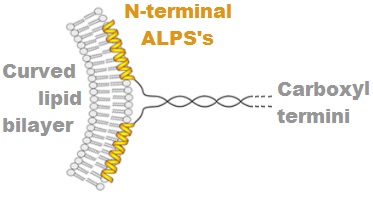Amphipathic Lipid Packing Sensor Motifs on:
[Wikipedia]
[Google]
[Amazon]
Amphipathic Lipid Packing Sensor (ALPS) motifs were first identified in 2005 in  The curving of a phospholipid
The curving of a phospholipid
ARFGAP1
ADP-ribosylation factor GTPase-activating protein 1 is an enzyme that in humans is encoded by the ''ARFGAP1'' gene. Two transcript variants encoding different isoforms have been found for this gene.
Function
The protein encoded by this gene i ...
and have been reviewed.
 The curving of a phospholipid
The curving of a phospholipid bilayer
A bilayer is a double layer of closely packed atoms or molecules.
The properties of bilayers are often studied in condensed matter physics, particularly in the context of semiconductor devices, where two distinct materials are united to form jun ...
, for example into a liposome
A liposome is a small artificial Vesicle (biology and chemistry), vesicle, spherical in shape, having at least one lipid bilayer. Due to their hydrophobicity and/or hydrophilicity, biocompatibility, particle size and many other properties, lipo ...
, causes disturbances to the packing of the lipids on the side of the bilayer that has the larger surface area (the outside of a liposome for example). The less "ordered" or "looser" packing of the lipids is recognized by ALPS motifs.
ALPS motifs are 20 to 40 amino acid
Amino acids are organic compounds that contain both amino and carboxylic acid functional groups. Although hundreds of amino acids exist in nature, by far the most important are the alpha-amino acids, which comprise proteins. Only 22 alpha a ...
long portions of proteins that have important collections of types of amino acid residues. Bulky hydrophobic
In chemistry, hydrophobicity is the physical property of a molecule that is seemingly repelled from a mass of water (known as a hydrophobe). In contrast, hydrophiles are attracted to water.
Hydrophobic molecules tend to be nonpolar and, t ...
amino acid residues, such as Phenylalanine, Leucine
Leucine (symbol Leu or L) is an essential amino acid that is used in the biosynthesis of proteins. Leucine is an α-amino acid, meaning it contains an α- amino group (which is in the protonated −NH3+ form under biological conditions), an α- ...
, and Tryptophan
Tryptophan (symbol Trp or W)
is an α-amino acid that is used in the biosynthesis of proteins. Tryptophan contains an α-amino group, an α-carboxylic acid group, and a side chain indole, making it a polar molecule with a non-polar aromatic ...
are present every 3 or 4 positions, with many polar
Polar may refer to:
Geography
Polar may refer to:
* Geographical pole, either of two fixed points on the surface of a rotating body or planet, at 90 degrees from the equator, based on the axis around which a body rotates
* Polar climate, the c ...
but uncharged amino acid residues such as Glycine
Glycine (symbol Gly or G; ) is an amino acid that has a single hydrogen atom as its side chain. It is the simplest stable amino acid ( carbamic acid is unstable), with the chemical formula NH2‐ CH2‐ COOH. Glycine is one of the proteinog ...
, Serine and Threonine between. The ALPS is unstructured in solution but folds as an alpha helix when associated with the membrane bilayer, such that the hydrophobic residues insert between loosely packed lipids and the polar residues point toward the aqueous
An aqueous solution is a solution in which the solvent is water. It is mostly shown in chemical equations by appending (aq) to the relevant chemical formula. For example, a solution of table salt, or sodium chloride (NaCl), in water would be re ...
cytoplasm
In cell biology, the cytoplasm is all of the material within a eukaryotic cell, enclosed by the cell membrane, except for the cell nucleus. The material inside the nucleus and contained within the nuclear membrane is termed the nucleoplasm. ...
.
References
{{reflist Membrane biology Molecular biology Proteins es:Motivo estructural ALPS